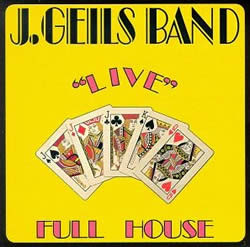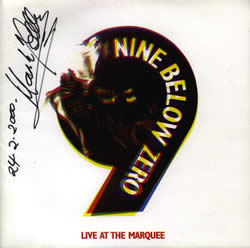Swing Job – Mark Feltham […with tab]
Welcome to the second part of our trilogy, covering the top three harp tracks from 9 Below Zero‘s debut Live At The Marquee album, released on A&M in 1980. By that time the UK had already experienced the revolution of Punk Rock and DIY record labels such as Stiff, Beggars Banquet and Rough Trade. New Wave was virtually passe, two-tone ska was skanking it’s heart out and dueling shirted New Romantics such as The Teardrop Explodes and Duran Duran were waiting in the wings, busily back-combing.
Meanwhile, somewhere down London’s Old Kent Road, producer/manager Mickey Modern stepped forward and offered to represent Stan’s Blues Band, a then pub-rock R&B outfit that was causing a big stir south of the river. His timing was perfect. Amidst the rash of new sub-cultures, the UK was also experiencing an R&B revival. Stan’s Blues Band changed its name to 9 Below Zero and jumped the crest of the R&B wave. Mickey went on to manage Nik Kershaw amongst other 80s acts.
 The newly named 9 Below Zero duly released an eponymous EP on M&L records, featuring cover versions of Pack Fair And Square, Rocket 88, Last Night and Tore Down. A year later, Live At The Marquee bowled in, tweaked noses and blew everyone away. My own copy hogged the bedroom turntable for months, occasionally moving aside for The Fabulous Thunderbirds, The Blues Band or The Cheaters. Of the fourteen tracks on Live At The Marquee, L&N, Pack Fair And Square and Swing Job were pure harmonica ear candy. The adventure of decoding the harp parts began.
The newly named 9 Below Zero duly released an eponymous EP on M&L records, featuring cover versions of Pack Fair And Square, Rocket 88, Last Night and Tore Down. A year later, Live At The Marquee bowled in, tweaked noses and blew everyone away. My own copy hogged the bedroom turntable for months, occasionally moving aside for The Fabulous Thunderbirds, The Blues Band or The Cheaters. Of the fourteen tracks on Live At The Marquee, L&N, Pack Fair And Square and Swing Job were pure harmonica ear candy. The adventure of decoding the harp parts began.
Later research revealed the main influences for 9 Below Zero’s rendition of Swing Job. The first was most definitely Whammer Jammer on the J.Geils Band’s 1972 live album Full House (originally recorded on the band’s second studio album ‘The Morning After’ a year earlier). Certain passages in Swing Job are too close a match for this not to have been 9 Below’s main inspiration. As an example, directly after the unaccompanied intro section, Feltham uses the same run as Magic Dick: 2D 3D 4D 5D (4D 3D) 2D 3D 4D 5D (4D 3D) 2D 3D 4D 5D 5B 4D. Albeit Magic Dick rapidly trills the last three notes. Feltham also employs Dick’s trademark stabs 4D 4D 4D 4D..4D’..4D 4D..4D’..4D, 4D 4D 4D 4D..4D’..4D 4D..4D’..4D. This notwithstanding, both tracks are fine examples of juggernaut power harping.
9 Below’s second influence may be slightly less obvious, but it’s clearly in there; Charlie Musselwhite‘s Harpin’ On A Riff. You’ll find it on his 1978 album Harmonica According To Charlie Musselwhite or else on his Harpin’ On A Riff The Best Of Charlie Musselwhite album. “Charlie hits a soaring wail followed by a growl into the harp mic”Once again, after the opening sequence, Charlie uses that familiar 2D 3D 4D 5D ( 4D 3D) 2D 3D 4D 5D (4D 3D) 2D 3D 4D 5D 5B 4D run. He continues with another lick that Mark Feltham borrows, namely 3D” 4D 3D” 2D 3D” 4D 3D” 2D. Further into his instrumental, Charlie hits a soaring wail followed by a vocal growl into the harp mic 5D…..5D’ 5B 4D 4D’ 4B (3D’) 3D~4D 6B ‘owwwww’ (and yes Charlie uses that semi-draw bend in hole 5). On Swing Job, Feltham works through the same wail, descent and growl sequence without bends, but the impact is the same. For the record, Charlie’s track is copyrighted 1978 on Viper Music so it does appear to precede Swing Job by at least a year; possibly two.
I recently asked Charlie about his own influence for Harpin’ On A Riff after his gig at Brighton’s Komedia. ‘What do you mean?’ was his reply. I repeated the question and mentioned that Charlie had touched on the instrumental during his show. He gestured to me to speak louder. “There is a danger you’ll end up merging them into one”I tried a third time. ‘Oh Movin’ And Groovin’? It’s just a jam. It’s based on a Charlie Parker riff.’ He may have played Movin’ And Groovin’ that night as it has a brief passage in common with Harpin’ On A Riff, however I didn’t get the answer I was hoping for. I suggest you familiarise yourself with all three tracks (Swing Job, Whammer Jammer and Harpin’ On A Riff) as they are from the same family and all have a lot to offer. There is a danger you’ll end up merging them into one, but perhaps this is the start of your own new derivitive. Harpin’ On A Jammer Job. Or maybe Whammin’ On A Swing Riff.
So how did he do it?
 Grab an A harp. We’ll be playing cross harp in the key of E. One feature which makes this track both unique and special is Mark Feltham’s use of what I call the monkey swing technique on the opening riff. His attack, amplification and phrasing ensure that what follows is a Formula 1 ride around a familiar 12 bar circuit, afterburners torching.
Grab an A harp. We’ll be playing cross harp in the key of E. One feature which makes this track both unique and special is Mark Feltham’s use of what I call the monkey swing technique on the opening riff. His attack, amplification and phrasing ensure that what follows is a Formula 1 ride around a familiar 12 bar circuit, afterburners torching.
Once again don’t be fooled into thinking the sound is too big to tackle. The mic and amp set up produce peripheral audio details (woofs, surges and crunches) which you hear in the recording, but are largely amplification of the player’s breathing and movement across passing notes. Some of the finer detail is also obscured by the guitar track. Focus on the main thread, tone, breathing and diaphragm work. The rest will drop in naturally. Feltham uses a lot of power harp throat vibrato on his sustained draw notes too. If you haven’t yet mastered this technique, check it out in out harp skills section here.
Hyphenated notes (eg. 3D-4D) are played together as a split. Notes linked with dots (eg. 3D’…3D) are tied; run them together). Notes linked with a scrolled hyphen indicate a trill (eg 3D~4D).
Swing Job comprises a twelve bar unaccompanied intro followed by nine twelve bar sequences.
12 bar unaccompanied intro
2D 2D 2D..2D”
2D 1D 2B 2D 2D” 1D
3D’ 2D 3D” 2D 2D” 1D 1B 1D 2D (the ‘Monkey Swing’)
2D 2D 2D..2D”
2D 1D 2B 2D 2D” 1D
3D’ 2D 3D” 2D 2D” 1D 1B 1D 2D ((the ‘Monkey Swing’)
2D..2D” 1D 4D 4B 4D…(gliss.down)
1B 4B 3D’…….
1st 12 bar sequence
2D 3D 4D 5D (rapidly)
2D 3D 4D 5D (rapidly)
2D 3D 4D 5D 5B 4D (rapidly)
2D 3D 4D 5D (rapidly)
2D 3D 4D 5D (rapidly)
2D 3D 4D 5D 5B 4D 4B (rapidly)
3D’..3D 4D 3D’ 2D
3D’..3D 4D 3D’ 2D
2D 3D 4D 5D (rapidly)
2D 3D 4D 5D (rapidly)
2D 3D 4D 5D 5B 4D 4B (rapidly)
1D..4D 4D 4D..1D
1B..4B 3D’..3D”..2D 2B 2D
3D’..3D 2D 2B 2D 2D” 1D
2nd 12 bar sequence
3D’………….4B 4D’ 4D
1B-4B 2B-5B 4D’…4D~5D
3D’ 3D” 2D 3D”……….
3D’..3D” 3D’..3D” 2D 2B
2D 2D’..2D..2D”..1D
2D 2D” 1D 1D
3rd 12 bar sequence
3D’..3D 4D 6B 5D
3D’..3D 4D 6B 5D
3D’..3D 4D 6B 5D
3D’..3D 4D 6B 5D
3D’..3D 4D 6B 6B
3D’..3D 4D 6B 6B
3D’..3D 4D 6B 5D
3D’..3D 4D 6B 5D
3D’..3D~4D…………………
4th 12 bar sequence
4D..4D 4D 4D
4D..4D’..4D 4D..4D’..4D
4D 4D 4D
4D..4D’..4D 4D..4D’..4D
4D 4D 4D
4D..4D’..4D 4D..4D’..4D
4D 4D 4D
4D..4D’..4D 4D..4D’..4D
Gliss.down to 1D and back up to 4D
Drum splash
5th 12 bar sequence
2D 2D 2D
2D 2B 2D
3D’ 2D 3D” 2D 2D” 1D 1B 1D 2D (the ‘Monkey Swing’)
2D 2D 2D
3D’..3D 4D 4D 3D 4D 5B
3D’ 3D” 2D 2D” 1D 1B 1D 2D (the ‘Monkey Swing II’)
2D” 1D 4D 4B
1B 4B 3D’
2D 2D 2D
1D..2B 2D 2D” 1D 1D
6th 12 bar sequence
2D..2D 2D..2D 2D..2D 2D..2D
2D..2D 2D..2D 3D’-3D’ 2D..2D
3D’-3D’ 2D..2D 4D’..4D..4D’ 2D..2D
3D’-3D’ 3D’-3D’ 3D’-3D’ 3D’-3D’
3D’-3D’ 3D’-3D’
2D’..2D 1D..2D”..1D..2D” 1D..1B..1D
2D 2D” 1D 1D
7th 12 bar sequence
2D gliss.up to 5D
4D 5D 5B 4D 4B
3D’..3D~4D….. 6B (followed by vocal growl into mic..’owww!’)
2D gliss.up to 5D
4D 5D 5B 4D 4B
3D’..3D~4D….. 6B (followed by vocal growl into mic..’owww!’)
4D 5D 4D 5D 4D..4D’
2D..3D 2D..B 2D
2D 2D 3D’..3D 2D 2B
2D 2D” 1D 1D
8th 12 bar sequence
3D’..3D 4D 6B 5D
3D’..3D 4D 6B 5D
3D’..3D 4D 6B 5D
3D’..3D 4D 6B 5D
3D’..3D 4D 6B 6B
3D’..3D 4D 6B 6B
3D’..3D 4D 6B 5D
3D’..3D 4D 6B 5D
3D’..3D~4D…………………
9th 12 bar sequence
4D..4D 4D 4D
4D..4D’..4D 4D..4D’..4D
4D 4D 4D
4D..4D’..4D 4D..4D’..4D
4D 4D 4D
4D..4D’..4D 4D..4D’..4D
4D 4D 4D
4D..4D’..4D 4D..4D’..4D
Gliss.down to 1D and back up to 4D
Drum splash plus final guitar stab on the down beat of (what would be) the next 12 bar sequence.
‘Thank you. Good night!’

